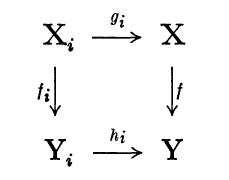What does it mean for a property P of morphisms of schemes to be etale local on the source and target? In Deligne-Mumford they use the following definition (page 100): for any family of commutative squares

where {h_i : X_i —> X}, {g_i : Y_i —> Y} are etale coverings we have P(f) <=> P(f_i) for all i. And of course this is exactly the minimum needed to be able to define what it means for a morphism of Deligne-Mumford stacks to have a certain property…
However, here are some very confusing points
- the condition does NOT imply that P is preserved under post-composing with open immersions,
- if P is etale local on the source and P is etale local on the target, then P does not necessarily satisfy Deligne and Mumford’s condition.
Now it turns out that this NEVER leads to any confusion, since if P is preserved under post-composing with open immersions, which is a condition always satisfied in practice, then all three conceivable notions agree. Moreover, in that case the property is preserved under post-composing with etale morphisms. To see all the gory details, see the section entitled “Properties of morphisms local on source-and-target” in Descent.pdf.
PS: This may be good material to read if you are having trouble falling asleep.
